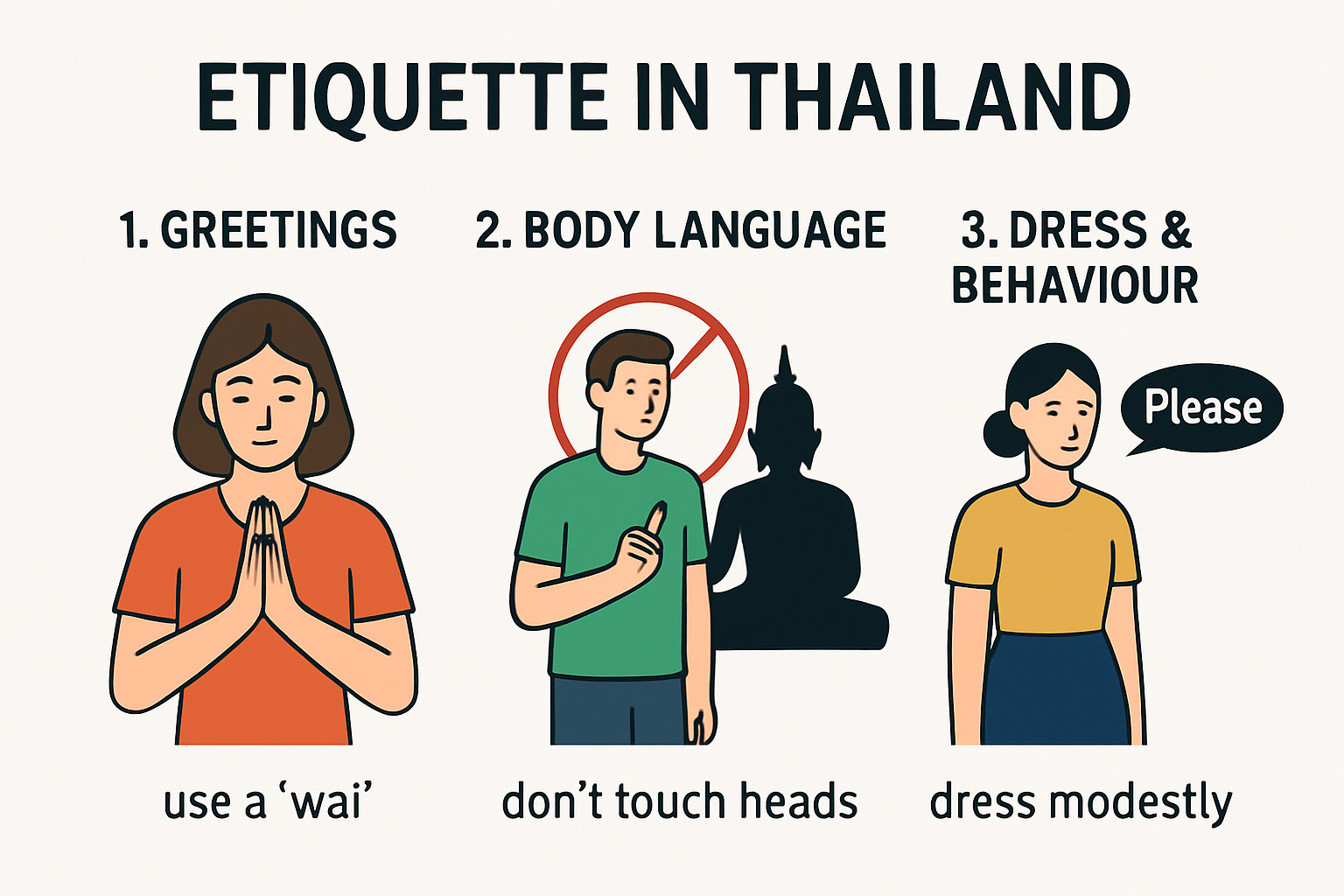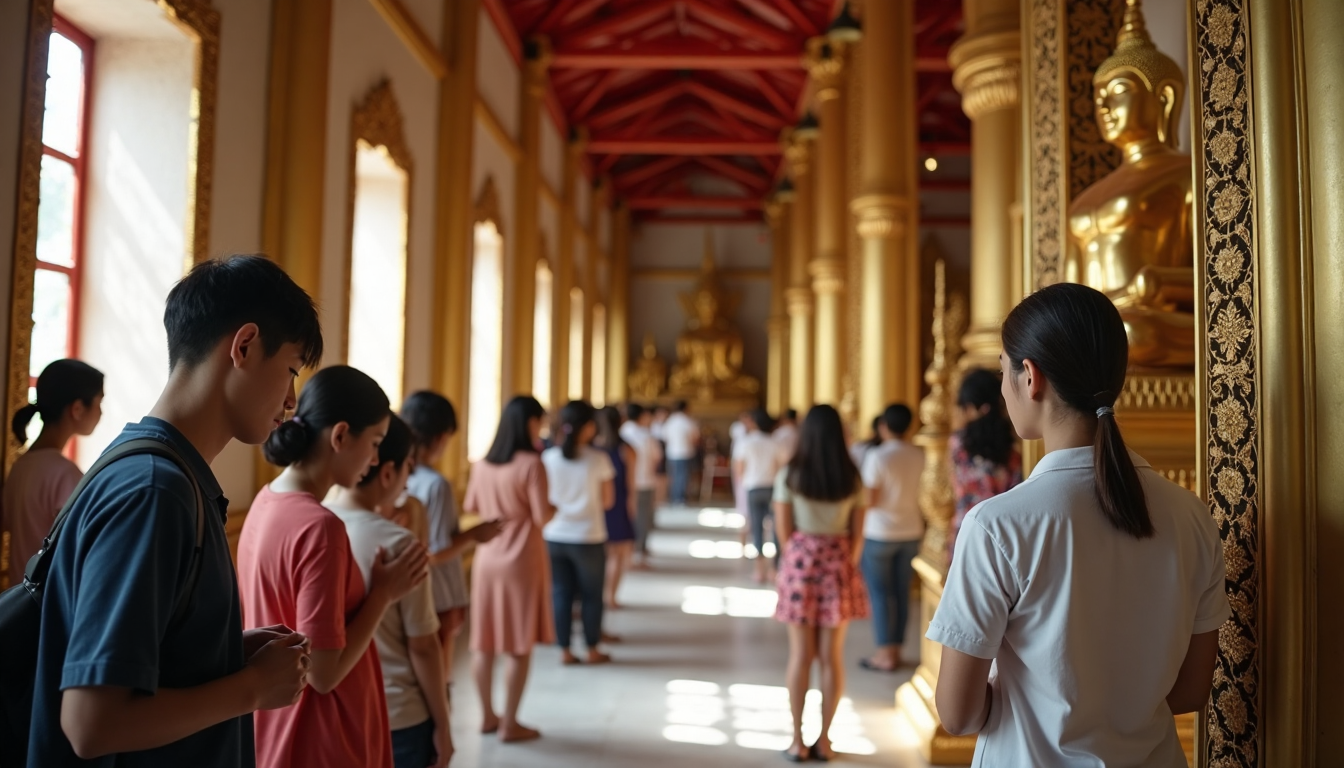
Visiting Thailand as a traveller from Germany, the UK or the US promises dazzling temples and vibrant street life. Yet, here’s a surprise. Over 70 percent of tourists make etiquette mistakes that locals notice immediately. It turns out the smallest gestures and words matter far more than dress codes or tour plans, and mastering these can be the real key to feeling welcome in Thailand.
Table of Contents
- Understanding Thai Culture And Local Manners
- Dressing Appropriately: What To Wear In Thailand
- Communicating And Socialising With Locals
- Avoiding Common Tourist Mistakes In Thailand
Quick Summary
| Takeaway | Explanation |
|---|---|
| Embrace ‘kreng jai’ | Understand the Thai cultural principle of respect, politeness, and consideration; avoid confrontation to maintain social harmony. |
| Dress Modestly | When visiting religious sites, ensure shoulders and knees are covered; avoid sleeveless tops and shorts to show respect for local customs. |
| Learn Basic Thai Phrases | Familiarise yourself with simple Thai greetings like ‘sawadee kha/khrap’ and ‘khob khun kha/khrap’ to enhance social interactions and demonstrate respect. |
| Be Mindful of Body Language | Avoid actions that could be deemed disrespectful, such as touching someone’s head or pointing your feet, as body language holds significant meaning in Thai culture. |
| Prepare for Cultural Sensitivities | Stay informed about laws, especially regarding the monarchy, and be cautious about discussing sensitive topics to prevent legal issues while visiting Thailand. |
Understanding Thai Culture and Local Manners
Travelling to Thailand requires more than just packing your bags and booking tickets. To truly blend in as a traveller, understanding the nuanced cultural practices and social etiquette is paramount. Thai culture is deeply rooted in respect, social harmony, and subtle communication that can easily be misunderstood by visitors from Germany, the United Kingdom, and the United States.
Respectful Interactions and Social Norms
The cornerstone of Thai social interactions is the concept of ‘kreng jai’, a complex cultural principle that blends respect, politeness, and consideration for others’ feelings. According to Cultural Atlas, this means avoiding direct confrontation, maintaining composure, and never causing someone to lose face publicly.
A quintessential example of respectful interaction is the traditional greeting known as the ‘wai’. Wikipedia research reveals this gesture involves pressing palms together in a prayer-like position and bowing slightly. The height of your hands and the depth of your bow communicate the level of respect you’re showing. Visitors should observe and reciprocate this greeting, but be cautious not to initiate a wai with service workers or significantly younger individuals.
Body language speaks volumes in Thai culture. The head is considered sacred, while feet are viewed as the lowest part of the body. Cultural experts strongly advise against touching someone’s head or pointing your feet towards people or religious objects, as these actions are profoundly disrespectful.

Dress Code and Public Behavior
Dressing appropriately is crucial for blending in and showing respect. When visiting religious sites like temples, modest clothing is mandatory. Thailand’s Parliamentary Guidelines recommend covering shoulders and knees. This means avoiding sleeveless tops, short shorts, and revealing outfits, particularly in sacred spaces.
Public displays of emotion are generally discouraged in Thai society. Loud conversations, aggressive gestures, and public arguments are seen as inappropriate. Maintaining a calm, soft-spoken demeanor will help you integrate more seamlessly and demonstrate cultural sensitivity.
Navigating Social Hierarchies
Thai society operates on a hierarchical structure where age, social status, and professional rank significantly influence interactions. Younger individuals are expected to show deference to elders, and professionals are respected based on their position. When addressing people, using polite titles and maintaining a respectful tone is essential.
Language can be a powerful tool in demonstrating cultural understanding. Learning a few basic Thai phrases like ‘sawadee kha/khrap’ (hello) and ‘khob khun kha/khrap’ (thank you) can go a long way in showing respect and creating positive interactions with locals.
By approaching Thai culture with genuine curiosity, respect, and a willingness to learn, travellers from Germany, the UK, and the US can transform their experience from being mere tourists to becoming thoughtful, integrated visitors who appreciate the depth and beauty of Thai social dynamics.
Dressing Appropriately: What to Wear in Thailand
Navigating the clothing landscape in Thailand requires more than simply selecting comfortable travel wear. As a traveller from Germany, the United Kingdom, or the United States, understanding the nuanced dress codes across different settings will help you blend in seamlessly and show cultural respect.
Climate Considerations and Practical Clothing Choices
Thailand’s tropical climate demands lightweight, breathable fabrics that provide both comfort and cultural sensitivity. According to World Meteorological Organization, temperatures typically range between 25-35°C (77-95°F) year-round, necessitating clothing that allows air circulation and moisture wicking.
Light cotton shirts, linen trousers, and loose-fitting shorts become your best companions. For women, maxi dresses and lightweight wraps offer versatility, while men can opt for lightweight, neutral-toned shirts and comfortable cargo shorts. Travel Fashion Guide recommends choosing materials that dry quickly and resist humidity.
Packing a lightweight, neutral-colored light jacket or shawl proves essential. These pieces serve multiple purposes: protection from sudden rain showers, covering up in more conservative spaces, and providing an extra layer during cooler evenings or in air-conditioned spaces.
Religious and Cultural Dress Expectations
When visiting temples, religious sites, and formal settings, dress codes become significantly more stringent. Thailand’s Parliamentary Guidelines explicitly recommend modest attire that covers shoulders and knees. This means avoiding:
- Sleeveless tops
- Short shorts
- Transparent or revealing clothing
- Tight-fitting garments
For temple visits, carry a lightweight scarf or sarong that can quickly transform your outfit. Many temples provide rental cover-ups, but having your own ensures you’re always prepared. Closed-toe shoes or sandals that are easy to remove are recommended, as you’ll need to take off footwear before entering sacred spaces.
Urban and Beach Attire Distinctions
Thailand offers diverse environments, each with subtle dress code variations. In cosmopolitan areas like Bangkok, slightly more formal attire is appreciated. Business casual or smart casual clothing works well in restaurants, shopping centres, and professional settings.
Beach destinations like Phuket and Koh Samui offer more relaxed dress codes. However, Tourism Authority of Thailand advises against walking around town in swimwear. Always have a cover-up or change of clothes when moving from beach to street.
For evening outings, smart casual clothing works best. Men might choose collared shirts and tailored shorts, while women can opt for sundresses or lightweight evening wear. Avoid overly revealing clothing, which can be perceived as disrespectful.
Remember, dressing appropriately in Thailand is about more than fashion—it’s a form of cultural communication. By selecting clothing that respects local norms, you demonstrate cultural awareness and earn genuine appreciation from locals. Your thoughtful approach to dressing will transform you from a typical tourist to a culturally sensitive traveller.
To help you distinguish between appropriate dress in different Thai settings, here’s a summary table contrasting expected attire:
| Setting | Recommended Attire | What to Avoid |
|---|---|---|
| Religious Sites/Temples | Covered shoulders and knees, scarf/sarong, easy-off shoes | Sleeveless tops, shorts, revealing wear |
| Urban/City | Business/smart casual, collared shirts, neat dresses | Beachwear, flip-flops, athletic wear |
| Beaches | Swimwear for swimming; cover-up when off beach | Going to shops/restaurants in swimwear |
| Evenings/Restaurants | Smart casual, sundresses, tailored shorts | Very casual/overly revealing attire |
Communicating and Socialising with Locals
Communicating effectively in Thailand goes beyond mere language skills. For travellers from Germany, the United Kingdom, and the United States, understanding the subtle nuances of Thai social interactions can transform your travel experience from superficial tourism to meaningful cultural exchange.
Language and Communication Basics
While English is widely spoken in tourist areas, learning basic Thai phrases demonstrates respect and creates immediate connection. Sustainable Tourism Alliance suggests that simple greetings can significantly enhance your social interactions.
Key phrases to master include:
- Sawadee kha/khrap (Hello)
- Khob khun kha/khrap (Thank you)
- Mai pen rai (No worries/It’s nothing)
Pronunciation matters. The ‘kha’ (for females) and ‘khrap’ (for males) are important gender-specific endings that show politeness. Language Learning Experts recommend practicing these with a gentle, respectful tone.
Nonverbal communication is equally crucial. Maintaining a calm, soft-spoken demeanor and avoiding aggressive gestures or loud conversations will help you blend in seamlessly. Thai culture values emotional restraint and indirect communication.
Social Interaction and Cultural Engagement
Building genuine connections requires more than language skills. Bon Voyage Thailand emphasizes the importance of participating in local activities to truly understand Thai culture.
Consider engaging in experiences that facilitate meaningful interactions:
- Cooking classes: Learn traditional recipes while interacting with local instructors
- Local markets: Explore and chat with vendors about their products
- Community festivals: Participate in local celebrations and cultural events
Respect is the cornerstone of Thai social interactions. Always approach conversations with a smile, patience, and genuine curiosity. Avoid confrontational topics like politics or criticisms of the royal family, which can be considered deeply offensive.
Navigating Social Situations
Understanding social hierarchies is critical. Thai society operates on a complex system of respect based on age, social status, and professional rank. Cultural Anthropology Research suggests that younger individuals should show deference to elders, and professionals are respected based on their position.
When meeting new people, observe these key principles:
- Use polite titles when addressing individuals
- Avoid direct confrontation or public criticism
- Listen more than you speak
- Show genuine interest in learning about local culture
Technology can be a helpful bridge. Many younger Thais use social media and messaging apps like LINE, which can be great tools for making connections and learning more about local culture.
Remember, successful communication is about more than words. It’s about showing respect, demonstrating cultural sensitivity, and approaching interactions with an open heart and mind. By embracing these principles, travellers can transform their Thai experience from a simple vacation to a profound cultural journey of understanding and connection.
To support your everyday interactions and help you avoid common miscommunications, here’s a handy checklist of essential phrases and gestures in Thai culture:
| Phrase/Gesture | Meaning/Use | When to Use |
|---|---|---|
| Sawadee kha/khrap | Hello | Greeting anyone politely |
| Khob khun kha/khrap | Thank you | Expressing gratitude |
| Mai pen rai | No worries/It’s nothing | In response to thanks/apologies |
| Wai (palms together) | Traditional respectful greeting | When meeting/leaving; show respect |
| Smile | Friendly, non-verbal warmth | Throughout interactions |
| Avoid loud voices | Cultural expectation | All conversations |
| Avoid touching head | Respect for sacredness | Never touch another’s head |
| Don’t point feet | Cultural respect | Always (especially in temples) |
Avoiding Common Tourist Mistakes in Thailand
Navigating Thailand as a traveller from Germany, the United Kingdom, or the United States requires more than just enthusiasm—it demands cultural awareness and strategic preparation. Understanding and avoiding common tourist pitfalls can transform your experience from potentially awkward to genuinely memorable.
Legal and Cultural Sensitivities
One of the most critical areas for careful navigation involves understanding Thailand’s unique legal and cultural landscape. Thailand Holiday Group warns that tourists must exercise extreme caution regarding discussions about the monarchy. The country’s lèse-majesté laws are stringent, making it illegal to criticize or insult the royal family. Even seemingly innocuous comments can result in serious legal consequences.
Additionally, tourists often underestimate the importance of body language respect. Cultural Encyclopedia emphasizes that the head is considered sacred, while feet are viewed as the lowest part of the body. Actions that might seem harmless in Western cultures—such as patting someone’s head or pointing feet towards a person or religious object—can be deeply offensive.
Key actions to strictly avoid include:
- Touching anyone’s head without permission
- Pointing feet towards people or sacred objects
- Making negative comments about the royal family
- Publicly displaying aggressive emotions
Financial and Practical Precautions
Financial missteps can quickly derail a Thai travel experience. Tourism Financial Guide recommends several strategies to prevent common monetary mistakes:
- Always negotiate prices at markets, but do so with a smile and respectful demeanor
- Carry sufficient cash, as many smaller establishments do not accept credit cards
- Be cautious of overly aggressive street vendors and potential scams
- Learn basic price comparisons to understand fair market rates
Understanding local transportation can also prevent significant frustration. Negotiate taxi and tuk-tuk fares before starting your journey, and consider using ride-sharing apps for more transparent pricing. Some drivers might attempt to overcharge tourists who appear unfamiliar with local rates.
Religious and Social Etiquette Mistakes
Religious sites demand exceptional respect and careful behavior. Wikipedia Cultural Resources provides clear guidance on temple etiquette. Inappropriate dress or behavior can cause significant offense and potentially result in being asked to leave sacred spaces.
Essential temple visit guidelines include:
- Dress modestly (covered shoulders and knees)
- Remove shoes before entering
- Speak quietly and move respectfully
- Ask permission before photographing religious artifacts or monks
- Never turn your back on Buddha statues
Social interactions require similar nuanced understanding. Losing your temper or showing public frustration is considered extremely inappropriate. The Thai concept of ‘saving face’ means conflicts should be addressed privately and calmly.
The following table summarises common tourist mistakes in Thailand and the recommended approaches to avoid them:
| Mistake | Why It’s a Problem | How to Avoid |
|---|---|---|
| Discussing/criticising the monarchy | Strict lèse-majesté laws; legal consequences | Avoid the topic entirely |
| Touching someone’s head | Head considered sacred/disrespectful | Never touch another’s head |
| Pointing feet at people/objects | Feet viewed as lowest; seen as rude | Avoid pointing feet in any direction |
| Dressing inappropriately at temples | Shows disrespect, could be denied entry | Dress modestly, cover shoulders and knees |
| Entering religious sites with shoes | Considered disrespectful | Always remove shoes before entering |
| Losing temper in public | Loss of face; disrupts social harmony | Remain calm and composed at all times |
| Walking in swimwear away from beaches | Seen as culturally insensitive | Cover up when leaving beaches |
By approaching Thailand with genuine respect, cultural curiosity, and careful preparation, travellers can avoid common mistakes and create meaningful, positive interactions. Remember that every cultural misstep is an opportunity to learn and grow, transforming potential embarrassment into a moment of genuine cross-cultural understanding.

Frequently Asked Questions
How can I show respect when greeting locals in Thailand?
To show respect, use the traditional Thai greeting called the ‘wai,’ which involves pressing your palms together in a prayer-like gesture and bowing slightly. You can also learn basic Thai phrases like ‘sawadee kha/khrap’ (hello) and ‘khob khun kha/khrap’ (thank you) to enhance your interactions.
What should I wear when visiting temples in Thailand?
When visiting temples, it is essential to dress modestly. This includes covering your shoulders and knees. Avoid sleeveless tops, short shorts, and revealing clothing. Carrying a scarf or sarong can be helpful for covering up when needed.
What are some common tourist mistakes to avoid in Thailand?
Common mistakes include discussing the monarchy inappropriately, touching someone’s head, pointing your feet at people, and dressing inappropriately for religious sites. To avoid these pitfalls, it’s best to learn about local customs and behave respectfully.
How can I communicate effectively with locals in Thailand?
While English is spoken in tourist areas, learning a few basic Thai phrases can enhance your interactions. Use polite endings like ‘kha’ for females and ‘khrap’ for males. Additionally, maintain a calm demeanor and avoid loud conversations, as Thai culture values emotional restraint.
Experience Authentic Thailand Firsthand Before Your 2025 Trip
Better understanding Thai culture is only the beginning. Even with useful advice on ‘kreng jai’, dressing modestly and making respectful greetings, many travellers still feel uncertain about how all these customs play out in real life. If you worry about making etiquette mistakes or not blending in, seeing authentic day-to-day moments can make all the difference.

See Thailand through the lens of a local by watching our immersive walking travel videos. Discover how people behave in temples, how street greetings unfold and which unspoken rules guide public spaces. Every step is filmed in popular destinations like Koh Samui and Phuket so you can actually picture yourself there before you arrive. Start preparing for your journey now by visiting Traveller Channel. Watch our latest videos to study real interactions and gain the confidence to blend in from your very first day. If you want a travel experience that feels comfortable and connected, this is the best way to get ready.

Leave a Reply